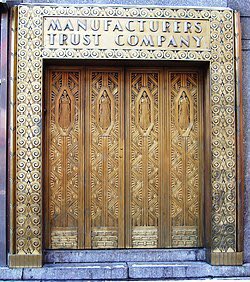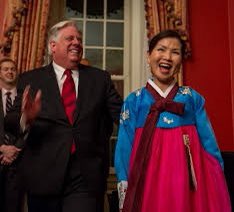
Qinetiq - Wikipedia
In early 2001, when defence minister Lewis Moonie announced the creation of Qinetiq via the privatisation of the Defence Evaluation and Research Agency (DERA). en.wikipedia.org/wiki/Qinetiq
In early 2001, when defence minister Lewis Moonie announced the creation of Qinetiq via the privatisation of the Defence Evaluation and Research Agency (DERA). en.wikipedia.org/wiki/Qinetiq
From 1973 to 1975 he was a trainee registrar in psychiatry. From 1975 to 1980 he was a research clinical pharmacologist and a medical advisor in the pharmaceutical industry in Switzerland, the Netherlands and Edinburgh. From 1980 to 1984, he was a trainee in community medicine
The Unification Church (UC), also known as the Unification Movement or Unificationism, is a new religious movement whose members are called Unificationists[2] and sometimes colloquially "Moonies". It was officially founded on 1 May 1954 under the name Holy Spirit Association for
the Unification of World Christianity (HSA-UWC) in Seoul, South Korea by Sun Myung Moon (1920–2012), a Korean religious leader also known for his business ventures and engagement in social and political causes In 1950, after serving 34 months of his sentence, Moon was released
from North Korea during the Korean War when United Nations troops advanced on the camp and the guards fled Moon moved to the United States in 1971, although he remained a citizen of the Republic of Korea. In the 1970s, he gave a series of public speeches in the United States,
including one in Madison Square Garden in New York City in 1974; two in 1976 in Yankee Stadium in New York City; and one on the grounds of the Washington Monument in Washington, DC, where he spoke on "God's Hope for America" to 300,000 people. In 1975, the HSA-UWC held one of
the largest peaceful gatherings in history, with 1.2 million people in Yeouido, South Korea.[57]
In the 1970s the Unification Church, along with some other new religious movements, became a target of the anti-cult movement. On the basis of theories that have not gained acceptance
In the 1970s the Unification Church, along with some other new religious movements, became a target of the anti-cult movement. On the basis of theories that have not gained acceptance
in mainline social science,[58] "anti-cult" activists accused the movement of having "brainwashed" its members. The Unification Church purchased the building in 1975, and two decades later, elected to convert a portion of the building to use as a hotel again. 

A bronze doorway in the New Yorker Hotel in midtown Manhattan that formerly led to a branch of the Manufacturers Trust Company
The corporation acquired the former Union Carbide Corporation headquarters at 270 Park Avenue, and though it merged into Chemical Banking Corporation
The corporation acquired the former Union Carbide Corporation headquarters at 270 Park Avenue, and though it merged into Chemical Banking Corporation

for $1.9 billion in 1991, the successor corporations down to today's J.P. Morgan Chase & Co. have continued to locate their headquarters in that building. In 1932, Manufacturers Trust created the National Hotel Management Company (NMH) to centrally oversee the hotels the bank
held mortgages on. They appointed hotel pioneer Ralph Hitz as President of the NMH. This was because, even at the height of the great depression, Hitz had been able to turn a profit at the New Yorker Hotel, which the Manufacturers Trust also held the mortgage for. By the time of
Hitz's death in 1940, the NHM had become the largest hotel organization in the United States and managed the New Yorker, the Lexington and the Belmont Plaza hotels (New York); the Congress Hotel (Chicago); the Netherland Plaza (Cincinnati); Adolphus Hotel (Dallas); the Van Cleve
(Dayton); the Book-Cadillac (Detroit); the Nicollet Hotel (Minneapolis); The New York Municipal Airport Restaurants (New York) and the Eastern Slope Inn (North Conway, New Hampshire). Following the merger with Chemical, in 1996, the new Chemical bought Chase Manhattan Bank and
four years later would merge with J.P. Morgan & Co. to form JPMorgan Chase.
Prior to acquisition, the bank was sometimes referred to as "Manny Hanny."
•1905 – Citizens Trust Company of Brooklyn (original New York State charter, no direct predecessors)
•1912 – Broadway
Prior to acquisition, the bank was sometimes referred to as "Manny Hanny."
•1905 – Citizens Trust Company of Brooklyn (original New York State charter, no direct predecessors)
•1912 – Broadway
Bank of Brooklyn
•1914 – Manufacturers National Bank of Brooklyn, resulting in name change to Manufacturers-Citizens Trust Company
•1915 – Name change to Manufacturers Trust Company (no merger involved)
•1918 – West Side Bank
•1921 – Ridgewood National Bank
•1914 – Manufacturers National Bank of Brooklyn, resulting in name change to Manufacturers-Citizens Trust Company
•1915 – Name change to Manufacturers Trust Company (no merger involved)
•1918 – West Side Bank
•1921 – Ridgewood National Bank
•1922 – North Side Bank of Brooklyn
•1922 – Industrial Bank of New York
•1923 – Columbia Bank
•1925 – Yorkville Bank
•1925 – Gotham National Bank
•1925 – Fifth National Bank of the City of New York
•1927 – Commonwealth Bank
•1927 – Standard Bank
•1922 – Industrial Bank of New York
•1923 – Columbia Bank
•1925 – Yorkville Bank
•1925 – Gotham National Bank
•1925 – Fifth National Bank of the City of New York
•1927 – Commonwealth Bank
•1927 – Standard Bank
•1928 – United Capitol National Bank and Trust Company
•1929 – State Bank & Trust Company
•1930 – Pacific Trust Company
•1931 – Midtown Bank of New York
•1931 – Bryant Park Bank
•1931 – Midwood Trust Company
•1932 – Chatham Phenix National Bank & Trust Company
•1929 – State Bank & Trust Company
•1930 – Pacific Trust Company
•1931 – Midtown Bank of New York
•1931 – Bryant Park Bank
•1931 – Midwood Trust Company
•1932 – Chatham Phenix National Bank & Trust Company
•1937 – Equitable Trust Company of New York (1930–1937)
•1939 – Banca Commerciale Italiana Trust Co. of New York
•1942 – Standard National Bank, Woodside, N.Y.
•1946 – Flatbush National Bank of Brooklyn
•1947 – Fidelity National Bank in New York, The
•1939 – Banca Commerciale Italiana Trust Co. of New York
•1942 – Standard National Bank, Woodside, N.Y.
•1946 – Flatbush National Bank of Brooklyn
•1947 – Fidelity National Bank in New York, The
•1949 – National Bronx Bank of New York
•1950 – Brooklyn Trust Company
•1953 – Peoples Industrial
•1961 – Central Hanover Bank & Trust Company, results in name change to Manufacturers Hanover Trust Company (parent named Manufacturers Hanover Corporation)
•1950 – Brooklyn Trust Company
•1953 – Peoples Industrial
•1961 – Central Hanover Bank & Trust Company, results in name change to Manufacturers Hanover Trust Company (parent named Manufacturers Hanover Corporation)
•1991 – Goldome (assets)[9]
•1992 – Purchased by Chemical Bank, and ceases to exist
The final name of the company was Manufacturers Hanover Corporation, and the primary banking subsidiary was Manufacturers Hanover Trust. This name was a result of the merger of predecessor
•1992 – Purchased by Chemical Bank, and ceases to exist
The final name of the company was Manufacturers Hanover Corporation, and the primary banking subsidiary was Manufacturers Hanover Trust. This name was a result of the merger of predecessor
Manufacturers Trust with Central Hanover Bank & Trust.
Central Hanover was also a large, well-known bank before the merger. It was formed in 1929 from the merger of two other banking giants of the time, Central Union Trust Company and Hanover National Bank.
Central Hanover was also a large, well-known bank before the merger. It was formed in 1929 from the merger of two other banking giants of the time, Central Union Trust Company and Hanover National Bank.
•1851 – Established Hanover Bank, NYS charter
•1865 – Name change to Hanover National Bank of the City of New York (Federal)
•1929 – Name change to Hanover Bank of the City of New York (NYS)
•1929 – Bought by Central Union Trust Company of New York Central Union
•1865 – Name change to Hanover National Bank of the City of New York (Federal)
•1929 – Name change to Hanover Bank of the City of New York (NYS)
•1929 – Bought by Central Union Trust Company of New York Central Union
Trust Company is as follows:[8][12]
•1873 – Established Central Trust Company of New York
•1901 – Continental National Bank of New York (est. 1853)
•1912 – Gallatin National Bank of the City of New York (est. 1829)
The corporate history of predecessor
•1873 – Established Central Trust Company of New York
•1901 – Continental National Bank of New York (est. 1853)
•1912 – Gallatin National Bank of the City of New York (est. 1829)
The corporate history of predecessor
•1918 –Union Trust Company of New York, changed name to Central Union Trust Company of New York
•1927 – Greenwich National Bank of the City of New York (est. 1830)
•1929 – Hanover Bank of the City of New York, changed name to Central Hanover Bank and Trust Company
•1927 – Greenwich National Bank of the City of New York (est. 1830)
•1929 – Hanover Bank of the City of New York, changed name to Central Hanover Bank and Trust Company
•1951 – Changed name to Hanover Bank (no merger)
•1961 – Bought by Manufacturers Trust Company
•1961 – Bought by Manufacturers Trust Company
• • •
Missing some Tweet in this thread? You can try to
force a refresh










